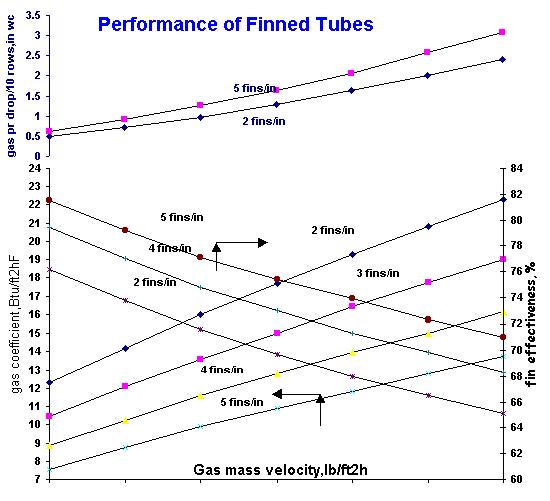The two examples presented below show why fins are used and also the importance of proper fin configuration. More examples can be found in my books.
WHY FINNED
TUBES?
Extended surfaces make boilers compact,reduce
their weight and gas pressure drop. They are particularly attractive
in low gas temperature (low log-mean-temperature difference)applications
such as gas turbine or diesel engine exhaust.
The table below compares the design of a bare
tube boiler with a finned tube boiler for the same gas temperature drop
and duty.
| case | bare tube | finned tube |
| gas flow,lb/h | 150,000 | 150,000 |
| gas inlet temp,F | 1000 | 1000 |
| exit gas temp,F | 382 | 382 |
| duty,MM Btu/h | 24.25 | 24.25 |
| steam pressure,psig | 150 | 150 |
| feed water temp,F | 240 | 240 |
| steam flow,lb/h | 24,500 | 24,500 |
| surface area,ft2 | 11670 | 20140 |
| U,Btu/ft2hF | 12.86 | 7.17 |
| gas pr drop,in wc | 4.5 | 3.15 |
| no of rows deep | 124 | 21 |
| heat flux,Btu/ft2h | 9213 | 52295 |
| tube wall temp,F | 385 | 484 |
Conclusions:
 The finned tube design is compact,as seen by the
number of rows deep,only 21 vs 124!
The finned tube design is compact,as seen by the
number of rows deep,only 21 vs 124!
 The overall heat transfer coefficient is much
lower for the finned tubes hence surface area is larger
The overall heat transfer coefficient is much
lower for the finned tubes hence surface area is larger
 Heat flux is much higher with finned tubes due
to the large ratio of external/internal surface area
Heat flux is much higher with finned tubes due
to the large ratio of external/internal surface area
 Tube wall temperature is hence much higher with
finned tubes
Tube wall temperature is hence much higher with
finned tubes
It
can be seen easily that surface areas with finned tube can be very
misleading.A larger surface area in the form of higher fin density does
not mean more duty.One has to look at the product of surface area and log-mean
temperature difference and not surface area alone! Besides increasing the
heat flux,and hence the tube wall,fin tip temperatures and gas pressure
drop,improper fin geometry can cost more too though the higher surface area may at first impress a few!!
The
example below shows the design of a superheater with different fin geometry.
The largest surface area design is not the best. However engineers not
familiar with heat transfer may be led to think that it is! See my books
for more examples.
PERFORMANCE
OF A SUPERHEATER WITH DIFFERENT FIN GEOMETRY
Results of superheater
design
Examples on the following topics can be found in my Books "Waste Heat Boiler Deskbook" and "Steam Plant Calculations Manual": It
can also be shown that higher the fin to tube surface,the tube wall and
fin tip temperatures will be higher as also the gas pressure drop. Higher
the fin density,lower the heat transfer coefficient and vice versa as seen
by the chart below for heat transfer in finned tubes.
It
can also be shown that higher the fin to tube surface,the tube wall and
fin tip temperatures will be higher as also the gas pressure drop. Higher
the fin density,lower the heat transfer coefficient and vice versa as seen
by the chart below for heat transfer in finned tubes.

Data:
gas
flow=200,000 lb/h
inlet
gas temp=1200 F
gas
analysis:% vol CO2=7,H2O=12,N2=75,O2=15
steam
flow=100,000 lb/h at 600 psig
tubes:2x0.120
T11;tubes/row=22,length=10ft,square pitch=4 in,fouling factors=0.001(gas/steam)
counter
flow configuration . Fin geometry was varied to obtain a duty ranging from
14 to 18 MM Btu/h. Equations used,Calculation procedures are described
in my books.
case no
1
2
3
4
duty,MM Btu/h
14.14
14.18
17.43
17.39
steam temp out,F
689
689
747
747
gas pr drop,in wc
0.65
1.20
1.15
1.37
gas exit temp,F
951
950
893
893
fins/in x ht x thick
2x0.5x0.075
5x0.75x0.075
2.5x0.75x0.075
4x0.75x0.075
surface area,ft2
2471
5342
5077
6549
tube wall temp,F
836
908
905
931
fin tip temp,F
949
1033
1064
1057
U,Btu/ft2hF
11.79
5.5
8.04
6.23
tube pr drop,psi
9.0
6.5
11.0
9.0
no of rows
6
4
7
6
fin effectiveness,%
84
72
68
70
Conclusions:
 Cases 1 and 2 have the same duty but due to differences
in fin geometry,see the difference in surface area,nearly 2.15 times! As
a result of the improper geometry,the tube wall and fin tip temperatures
are also higher!
Cases 1 and 2 have the same duty but due to differences
in fin geometry,see the difference in surface area,nearly 2.15 times! As
a result of the improper geometry,the tube wall and fin tip temperatures
are also higher!
 Overall heat transfer coefficient is lower for
case 2 versus 1 due to poor fin geometry
Overall heat transfer coefficient is lower for
case 2 versus 1 due to poor fin geometry
 Case 3 in fact transfer more duty with lessers
surface area compared to case 2.
Case 3 in fact transfer more duty with lessers
surface area compared to case 2.
 Cases 3 and 4 also reveal the same trend,namely
larger fin surface does not translate to more duty or better design.
Cases 3 and 4 also reveal the same trend,namely
larger fin surface does not translate to more duty or better design.

 Effect of inline versus staggered arrangement
Effect of inline versus staggered arrangement
 Solid versus serrated fins-impact on performance
Solid versus serrated fins-impact on performance
 Effect of fouling on boilers with different fin geometries
Effect of fouling on boilers with different fin geometries
 Optimization of fin geometry considering surface area,gas pressure drop
Optimization of fin geometry considering surface area,gas pressure drop